Soil Nutrient Contents in East African Climate-Smart Villages: Effects of Climate-Smart Agriculture Interventions
Abstract
:1. Introduction
2. Materials and Methods
2.1. Study Area
2.2. CSA Practices in Hoima, Nyando, and Lushoto Climate-Smart Villages
2.3. Soil Sampling and Analyses
2.4. Statistical Analysis
3. Results
3.1. Effect of CSA Practices on Macronutrients
3.2. Effect of CSA Practices on Micronutrients
4. Discussion
5. Conclusions
Author Contributions
Funding
Institutional Review Board Statement
Data Availability Statement
Acknowledgments
Conflicts of Interest
References
- IPCC. 2021: Summary for Policymakers. In Climate Change 2021: The Physical Science Basis. Contribution of Working Group I to the Sixth Assessment Report of the Intergovernmental Panel on Climate Change; Masson-Delmotte, V., Zhai, A.P., Pirani, S.L., Connors, C., Péan, S., Berger, N., Caud, Y., Chen, L., Goldfarb, M.I., Eds.; Cambridge University Press: Cambridge, UK, 2021. [Google Scholar]
- Recha, J.; Kimeli, P.; Atakos, V.; Radeny, M.; Mungai, C. Stories of Success: Climate-Smart Villages in East Africa. 2017. Available online: https://hdl.handle.net/10568/81030 (accessed on 10 July 2021).
- Reynolds, T.W.; Waddington, S.R.; Anderson, C.L.; Chew, A.; True, Z.; Cullen, A.C. Environmental impacts and constraints associated with the production of major food crops in Sub-Saharan Africa and South Asia. Food Secur. 2015, 7, 795–822. [Google Scholar] [CrossRef] [Green Version]
- WHO. The State of Food Security and Nutrition in the World 2020: Transforming Food Systems for Affordable Healthy Diets. 2020. Available online: http://www.fao.org/3/ca9692en/online/ca9692en.html (accessed on 23 June 2021).
- Partey, S.T.; Zougmoré, R.B.; Ouédraogo, M.; Campbell, B.M. Developing climate-smart agriculture to face climate variability in West Africa: Challenges and lessons learnt. J. Clean. Prod. 2018, 187, 285–295. [Google Scholar] [CrossRef]
- Adesodun, J.; Adeyemi, E.; Oyegoke, C. Distribution of nutrient elements within water-stable aggregates of two tropical agro-ecological soils under different land uses. Soil Tillage Res. 2007, 92, 190–197. [Google Scholar] [CrossRef]
- Aggarwal, P.K.; Jarvis, A.; Campbell, B.M.; Zougmoré, R.; Khatri-Chhetri, A.; Vermeulen, S.; Loboguerrero Rodriguez, A.; Sebastian, L.; Kinyangi, J.; Bonilla Findji, O. The climate-smart village approach: Framework of an integrative strategy for scaling up adaptation options in agriculture. Ecol. Soc. 2018, 23, 14. [Google Scholar] [CrossRef]
- Recha, J.W.; Radeny, M.A.; Kinyangi, J.; Kimeli, P.; Atakos, V.; Lyamchai, C.; Ngatoluwa, R.; Sayula, G. Climate-Smart Villages and Progress in Achieving Household Food Security in Lushoto, Tanzania; CCAFS Info Note; CGIAR Research Program on Climate Change, Agriculture and Food Security (CCAFS): Copenhagen, Denmark, 2015; Available online: https://ccafs.cgiar.org/resources/publications/climate-smart-villages-and-progress-achieving-household-food-security (accessed on 19 February 2022).
- Bullock, E.; Healey, S.; Yang, Z.; Oduor, P.; Gorelick, N.; Omondi, S.; Ouko, E.; Cohen, W. Three Decades of Land Cover Change in East Africa. Land 2021, 10, 150. [Google Scholar] [CrossRef]
- FAOSTAT. Statistics of the Food and Agriculture Organization of the United Nations; FAOSTAT: Rome, Italy, 2020; ISBN 9789251310120. [Google Scholar]
- Guzha, A.; Rufino, M.; Okoth, S.; Jacobs, S.; Nobrega, R. Impacts of land use and land cover change on surface runoff, discharge and low flows: Evidence from East Africa. J. Hydrol. Reg. Stud. 2018, 15, 49–67. [Google Scholar] [CrossRef]
- Bongiorno, G.; Bünemann, E.K.; Oguejiofor, C.U.; Meier, J.; Gort, G.; Comans, R.; Mäder, P.; Brussaard, L.; de Goede, R. Sensitivity of labile carbon fractions to tillage and organic matter management and their potential as comprehensive soil quality indicators across pedoclimatic conditions in Europe. Ecol. Indic. 2019, 99, 38–50. [Google Scholar] [CrossRef]
- Krauss, M.; Berner, A.; Perrochet, F.; Frei, R.; Niggli, U.; Mäder, P. Enhanced soil quality with reduced tillage and solid manures in organic farming—A synthesis of 15 years. Sci. Rep. 2020, 10, 4403. [Google Scholar] [CrossRef] [Green Version]
- Belayneh, M.; Yirgu, T.; Tsegaye, D. Effects of soil and water conservation practices on soil physicochemical properties in Gumara watershed, Upper Blue Nile Basin, Ethiopia. Ecol. Process. 2019, 8, 36. [Google Scholar] [CrossRef] [Green Version]
- Tanto, T.; Laekemariam, F. Impacts of soil and water conservation practices on soil property and wheat productivity in Southern Ethiopia. Environ. Syst. Res. 2019, 8, 13. [Google Scholar] [CrossRef]
- Galindo, F.S.; Delate, K.; Heins, B.; Phillips, H.; Smith, A.; Pagliari, P.H. Cropping System and Rotational Grazing Effects on Soil Fertility and Enzymatic Activity in an Integrated Organic Crop-Livestock System. Agronomy 2020, 10, 803. [Google Scholar] [CrossRef]
- Mureithi, S.M.; Verdoodt, A.; Gachene, C.K.K.; Njoka, J.T.; Wasonga, O.; De Neve, S.; Meyerhoff, E.; Van Ranst, E. Impact of enclosure management on soil properties and microbial biomass in a restored semi-arid rangeland, Kenya. J. Arid Land 2014, 6, 561–570. [Google Scholar] [CrossRef] [Green Version]
- Ambaw, G.; Recha, J.; Nigussie, A.; Solomon, D.; Radeny, M. Soil Carbon Sequestration Potential of Climate-Smart Villages in East African Countries. Climate 2020, 8, 124. [Google Scholar] [CrossRef]
- Wickama, J.; Okoba, B.; Sterk, G. Effectiveness of sustainable land management measures in West Usambara highlands, Tanzania. Catena 2014, 118, 91–102. [Google Scholar] [CrossRef]
- Massawe, H.J.B. Landform and Soil Analysis for Predicting Distribution of Plague Reservoirs and Vectors in Mavumo Area, Lushoto District, Tanzania. Ph.D. Thesis, Sokoine University of Agriculture, Morogoro, Tanzania, 2011. Available online: https://www.semanticscholar.org/paper/Landform-and-soil-analysis-forpredicting-of-plague-Massawe/ea6bfde77b3e215938bd710448d4372078da43ec (accessed on 23 June 2021).
- Kinyangi, J.; Recha, J.; Kimeli, P.; Atakos, V. Climate—Smart Villages and the Hope of Food Security in Kenya; CCAFS Info Note; CGIAR Research Program on Climate Change, Agriculture and Food Security (CCAFS): Copenhagen, Denmark, 2015; Available online: https://cgspace.cgiar.org/handle/10568/65144 (accessed on 19 February 2022).
- Gathenya, M.; Mwangi, H.; Coe, R.; Sang, J. Climate- and land use-induced risks to watershed services in the Nyando river Basin, Kenya. Exp. Agric. 2011, 47, 339–356. [Google Scholar] [CrossRef]
- Sijmons, K.; Kiplimo, J.; Förch, W.; Thornton, P.K.; Radeny, M.; Kinyangi, J. CCAFS Site Atlas–Nyando/KatukOdeyo; CCAFS Site Atlas Series; The CGIAR Research Program on Climate Change, Agriculture and Food Security (CCAFS): Copenhagen, Denmark, 2013. [Google Scholar]
- VanReeuwijk, L.P. Procedures for Soil Analysis, 3rd ed.; International Soil Reference and Information Center (ISRIC): Wageningen, The Netherlands, 1992; Available online: http://www.sciepub.com/reference/105119 (accessed on 9 January 2021).
- Mugwe, J.; Mugendi, D.; Mucheru-Muna, M.; Merckx, R.; Chianu, J.; Vanlauwe, B. Determinants of the decision to adopt integrated soil fertility management practices by smallholder farmers in the central highlands of Kenya. Exp. Agric. 2009, 45, 61–75. [Google Scholar] [CrossRef] [Green Version]
- Massawe, P.I.; Mtei, K.M.; Munishi, L.K.; Ndakidemi, P.A. Improving Soil Fertility and Crops Yield through Maize-Legumes (Common bean and Dolichos lablab) Intercropping Systems. J. Agric. Sci. 2016, 8, 148–166. [Google Scholar] [CrossRef]
- Tadesse, M.; Simane, B.; Abera, W.; Tamene, L.; Ambaw, G.; Recha, J.W.; Mekonnen, K.; Demeke, G.; Nigussie, A.; Solomon, D. The Effect of Climate-Smart Agriculture on Soil Fertility, Crop Yield, and Soil Carbon in Southern Ethiopia. Sustainability 2021, 13, 4515. [Google Scholar] [CrossRef]
- Deng, L.; Zhu, G.-Y.; Tang, Z.-S.; Shangguan, Z.-P. Global patterns of the effects of land-use changes on soil carbon stocks. Glob. Ecol. Conserv. 2016, 5, 127–138. [Google Scholar] [CrossRef] [Green Version]
- Tuo, Y.; Marcolini, G.; Disse, M.; Chiogna, G. A multi-objective approach to improve SWAT model calibration in alpine catchments. J. Hydrol. 2018, 559, 347–360. [Google Scholar] [CrossRef]
- Tsubo, M.; Walker, S.; Ogindo, H. A simulation model of cereal–legume intercropping systems for semi-arid regions: I. Model development. Field Crop. Res. 2005, 93, 10–22. [Google Scholar] [CrossRef]
- Fujita, K.; Ofosu-Budu, K.G.; Ogata, S. Biological nitrogen fixation in mixed legume-cereal cropping systems. Plant Soil 1992, 141, 155–175. [Google Scholar] [CrossRef]
- Hauggaard-Nielsen, H.; Jørnsgaard, B.; Kinane, J.; Jensen, E.S. Grain legume—Cereal intercropping: The practical application of diversity, competition and facilitation in arable and organic cropping systems. Renew. Agric. Food Syst. 2008, 23, 3–12. [Google Scholar] [CrossRef] [Green Version]
- Bedoussac, L.; Justes, E. The efficiency of a durum wheat-winter pea intercrop to improve yield and wheat grain protein concentration depends on N availability during early growth. Plant Soil 2010, 330, 19–35. [Google Scholar] [CrossRef]
- Dwivedi, A.; Dev, I.; Kumar, V.; Yadav, R.J.; Yadav, M.; Gupta, D.; Singh, A.; Tomar, S.S. Potential role of maize-legume in-tercropping systems to improve soil fertility status under smallholder farming systems for sustainable agriculture in India. Int. J. Life Sci. Biotechnol. Pharma Res. 2015, 4, 145–157. [Google Scholar]
- Hossain, Z.; Wang, X.; Hamel, C.; Knight, J.D.; Morrison, M.J.; Gan, Y. Biological nitrogen fixation by pulse crops on the semiarid Canadian Prairie. Can. J. Plant Sci. 2016, 97, 119–131. [Google Scholar] [CrossRef]
- Ndakidemi, P.A. Manipulating legume/cereal mixtures to optimize the above and below ground interactions in the traditional African cropping systems. Afr. J. Biotechnol. 2006, 5, 2526–2533. [Google Scholar]
- Palm, C.A.; Myers, R.J.K.; Nandwa, S.M. Combined Use of Organic and Inorganic Nutrient Sources for Soil Fertility Maintenance and Replenishment. In Replenishing Soil Fertility in Africa. SSSA Special Publication No 51; Buresh, R.J., Sanchez, P.A., Calhoun, F., Eds.; American Society of Agronomy: Madison, WI, USA, 1997; pp. 193–217. [Google Scholar]
- Mutuo, P.K.; Mukalama, J.P.; Agunda, J. On-farm testing of organic and inorganic phosphorus sources on maize in Western Kenya. TSBF Rep. 2000, 22, 1–48. [Google Scholar]
- Pieri, C. Fertilization des cultures vivrières et fertilité des sols en agriculture paysannesubsaharienne. Agron. Trop. 1986, 41, 1–20. [Google Scholar]
- Fisher, R.F. Amelioration of Degraded Rain Forest Soils by Plantations of Native Trees. Soil Sci. Soc. Am. J. 1995, 59, 544–549. [Google Scholar] [CrossRef] [Green Version]
- Harcombe, R. Soil nutrient loss as a factor in early tropical secondary succession. Biotropica 1980, 12, 8–15. [Google Scholar] [CrossRef]
- Gautam, T.P.; Mandal, T.N. Storage and Flux of Nutrients in Disturbed and Undisturbed Tropical Moist Forest of Eastern Nepal. Int. J. For. Res. 2018, 2018, 8516321. [Google Scholar] [CrossRef]
- Veen, C.; Fry, E.L.; Hooven, F.C.T.; Kardol, P.; Morriën, E.; De Long, J.R. The Role of Plant Litter in Driving Plant-Soil Feedbacks. Front. Environ. Sci. 2019, 7, 168. [Google Scholar] [CrossRef]
- Recha, J.W.; Olale, K.O.; Sila, A.M.; Ambaw, G.; Radeny, M.; Solomon, D. Measuring Soil Quality Indicators under Different Climate-Smart Land Uses across East African Climate-Smart Villages. Agronomy 2022, 12, 530. [Google Scholar] [CrossRef]

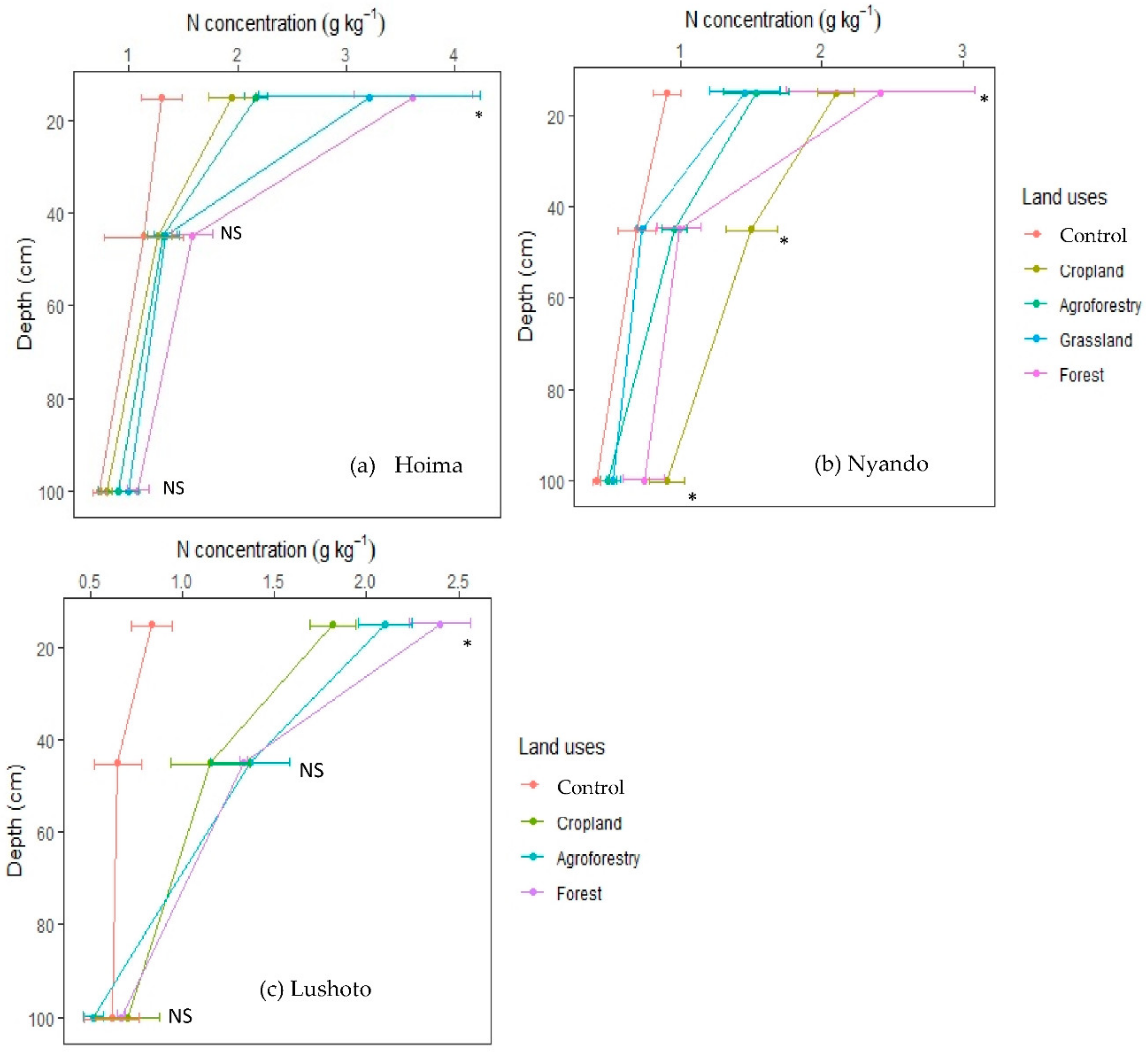
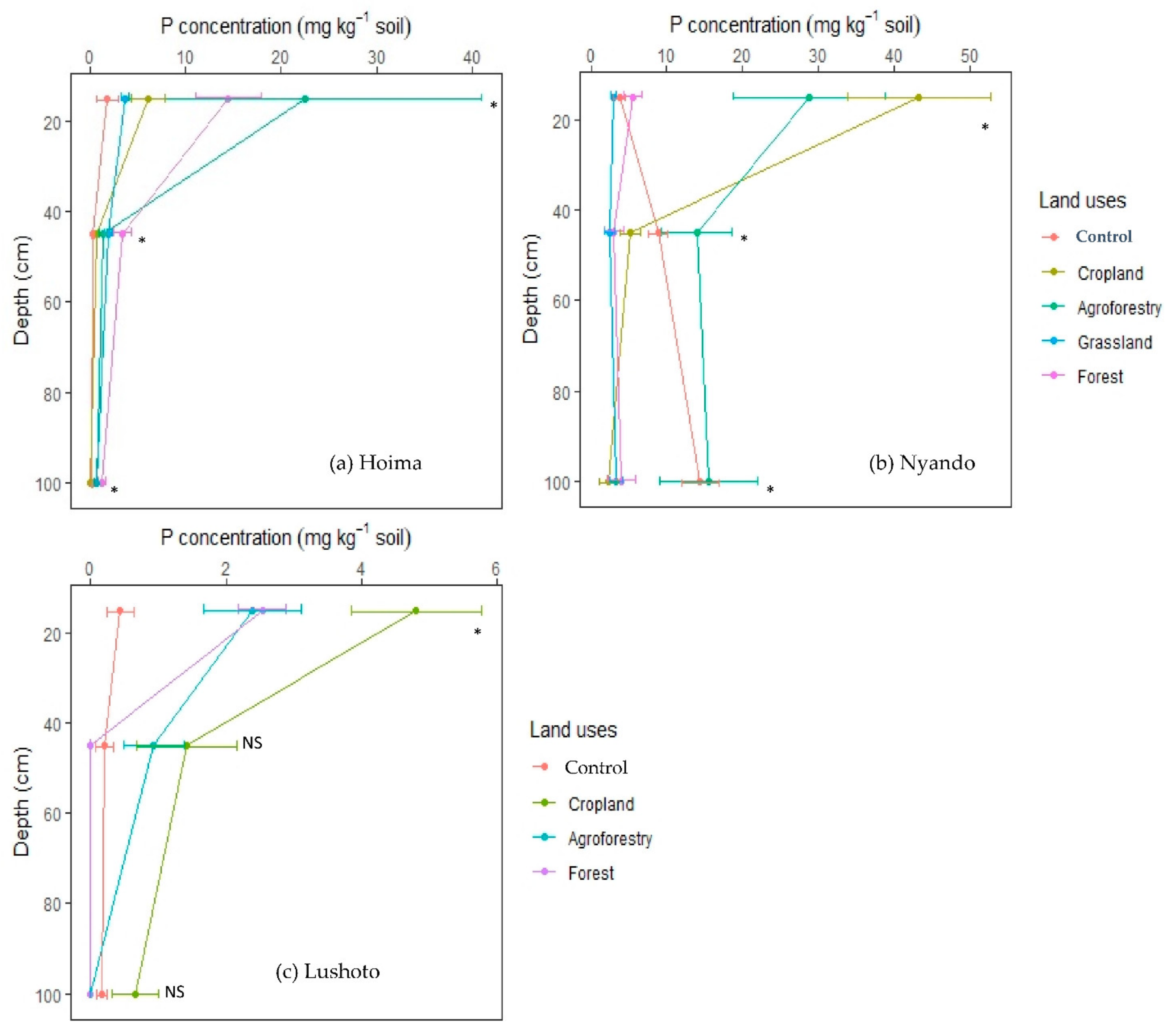
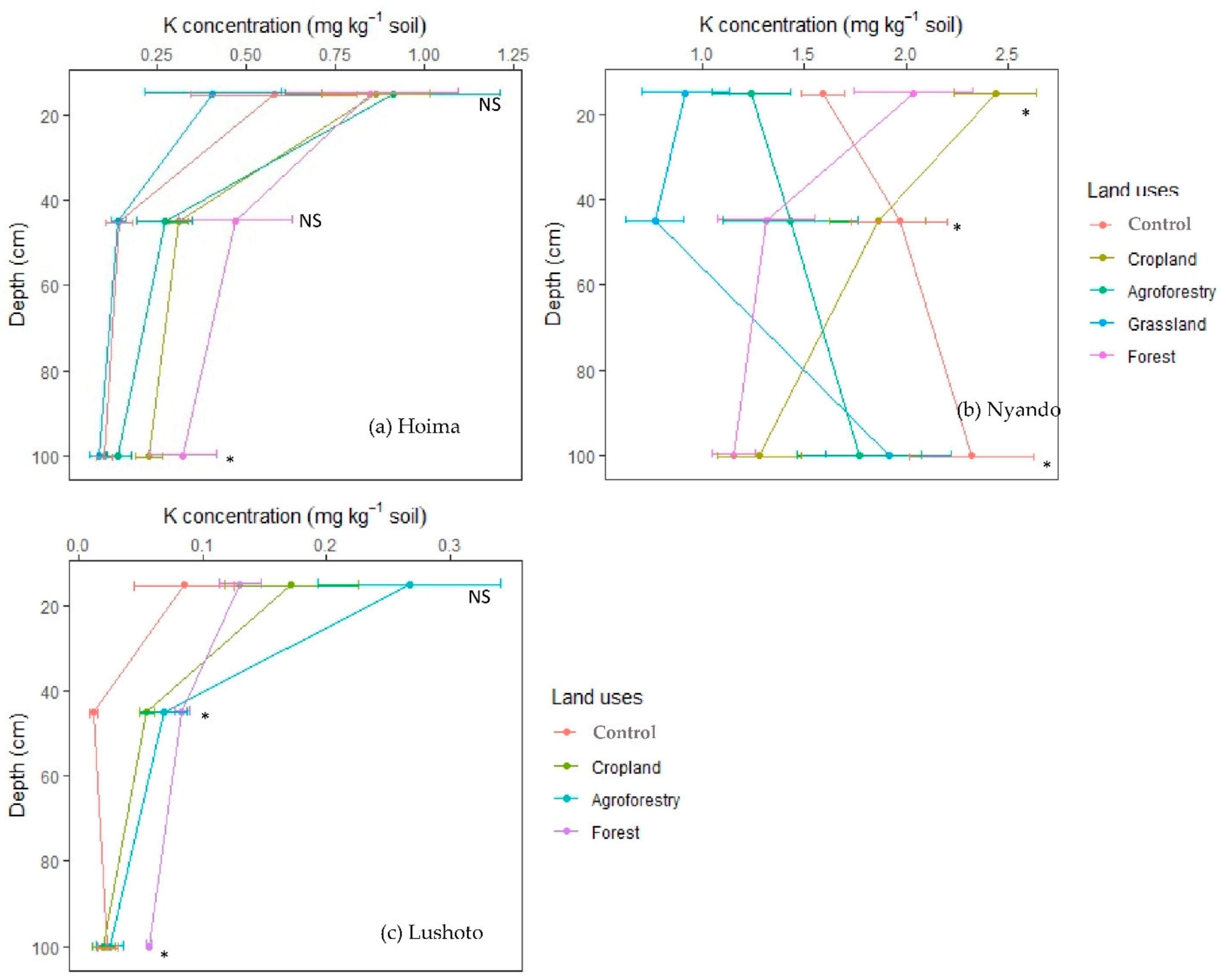
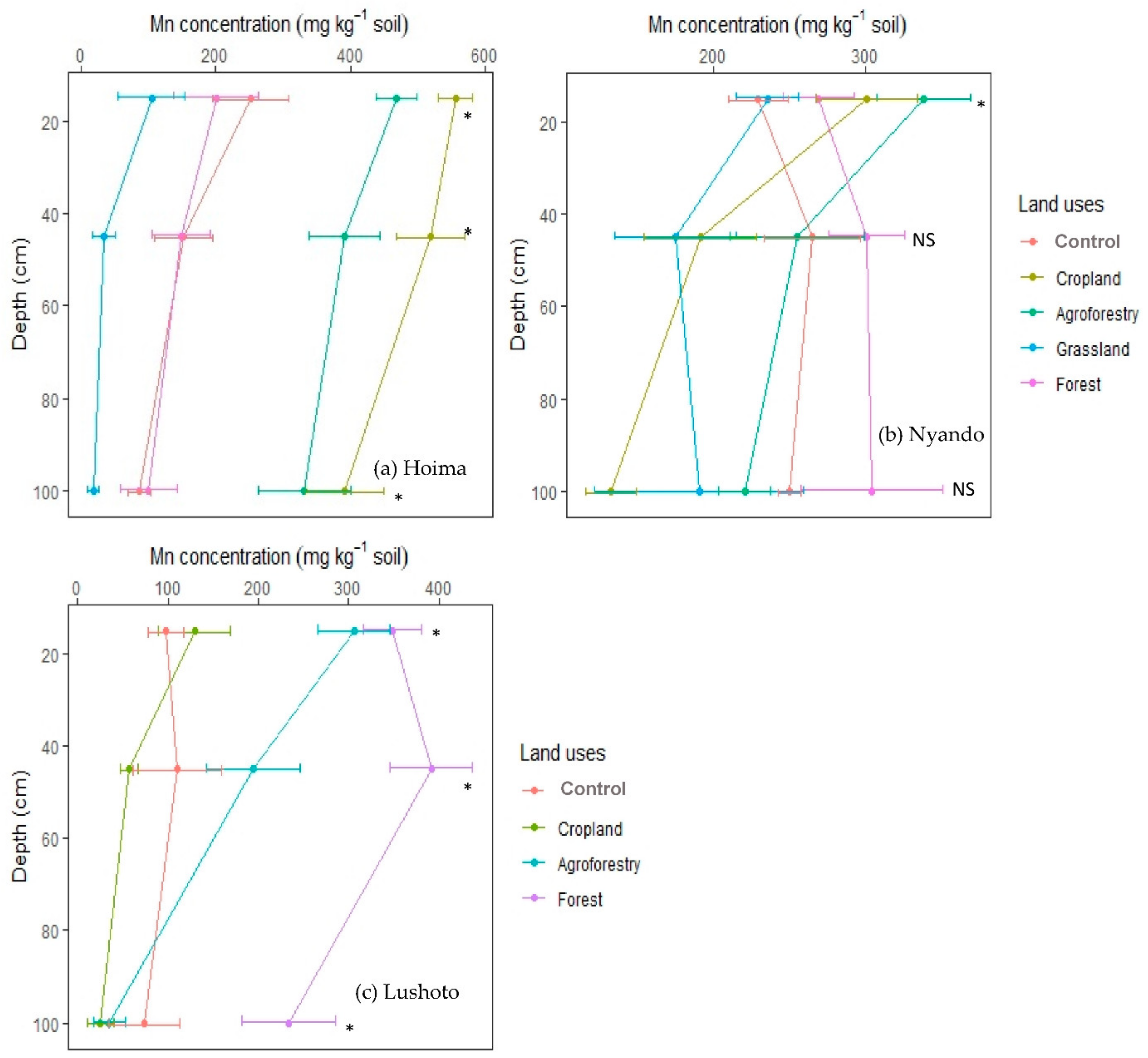
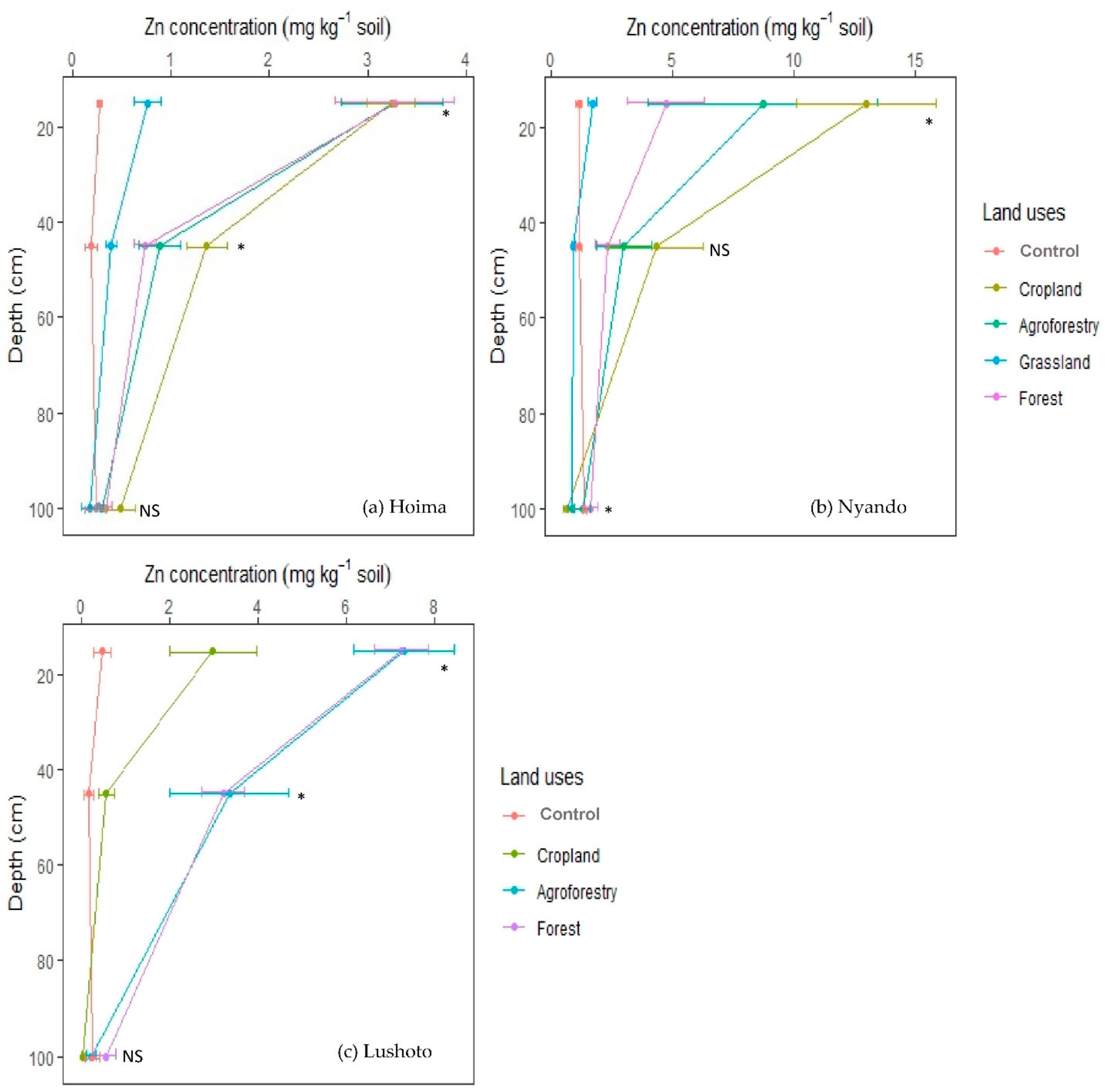
| Land Uses | Implemented CSA Practices | ||
|---|---|---|---|
| Hoima | Nyando | Lushoto | |
| Agroforestry | Use of farmyard manure, Addition of ash and household waste Integration of leguminous trees, fruit trees, crops, and vegetables | Integrated physical and biological SWC measures Use of farmyard manure. Addition of ash and household waste Integration of leguminous trees, fruit trees, crops, and vegetables Water harvesting | Integrated physical and biological SWC measures. Integration of leguminous trees with crops |
| Cropland | Integrated physical and biological soil and water Conservation measures. Crop rotation Improved varieties Intercropping | Integrated physical and biological soil and water Conservation measures. Crop rotation Improved varieties Intercropping | Integrated physical and biological soil and water Conservation measures. Crop rotation Improved varieties Intercropping |
| Grassland | Area enclosure Cut-and-carry system | Rotational grazing Area enclosure | Not sampled |
| Forest | Area enclosure Integrated physical and biological SWC measures | Area enclosure Integrated physical and biological SWC measures | Area enclosure Integrated physical and biological SWC measures |
| Control | CSApractices not implemented | CSA practices not implemented | CSA practices not implemented |
Publisher’s Note: MDPI stays neutral with regard to jurisdictional claims in published maps and institutional affiliations. |
© 2022 by the authors. Licensee MDPI, Basel, Switzerland. This article is an open access article distributed under the terms and conditions of the Creative Commons Attribution (CC BY) license (https://creativecommons.org/licenses/by/4.0/).
Share and Cite
Recha, J.W.; Ambaw, G.; Nigussie, A.; Radeny, M.; Solomon, D. Soil Nutrient Contents in East African Climate-Smart Villages: Effects of Climate-Smart Agriculture Interventions. Agriculture 2022, 12, 499. https://doi.org/10.3390/agriculture12040499
Recha JW, Ambaw G, Nigussie A, Radeny M, Solomon D. Soil Nutrient Contents in East African Climate-Smart Villages: Effects of Climate-Smart Agriculture Interventions. Agriculture. 2022; 12(4):499. https://doi.org/10.3390/agriculture12040499
Chicago/Turabian StyleRecha, John Walker, Gebermedihin Ambaw, Abebe Nigussie, Maren Radeny, and Dawit Solomon. 2022. "Soil Nutrient Contents in East African Climate-Smart Villages: Effects of Climate-Smart Agriculture Interventions" Agriculture 12, no. 4: 499. https://doi.org/10.3390/agriculture12040499
APA StyleRecha, J. W., Ambaw, G., Nigussie, A., Radeny, M., & Solomon, D. (2022). Soil Nutrient Contents in East African Climate-Smart Villages: Effects of Climate-Smart Agriculture Interventions. Agriculture, 12(4), 499. https://doi.org/10.3390/agriculture12040499






